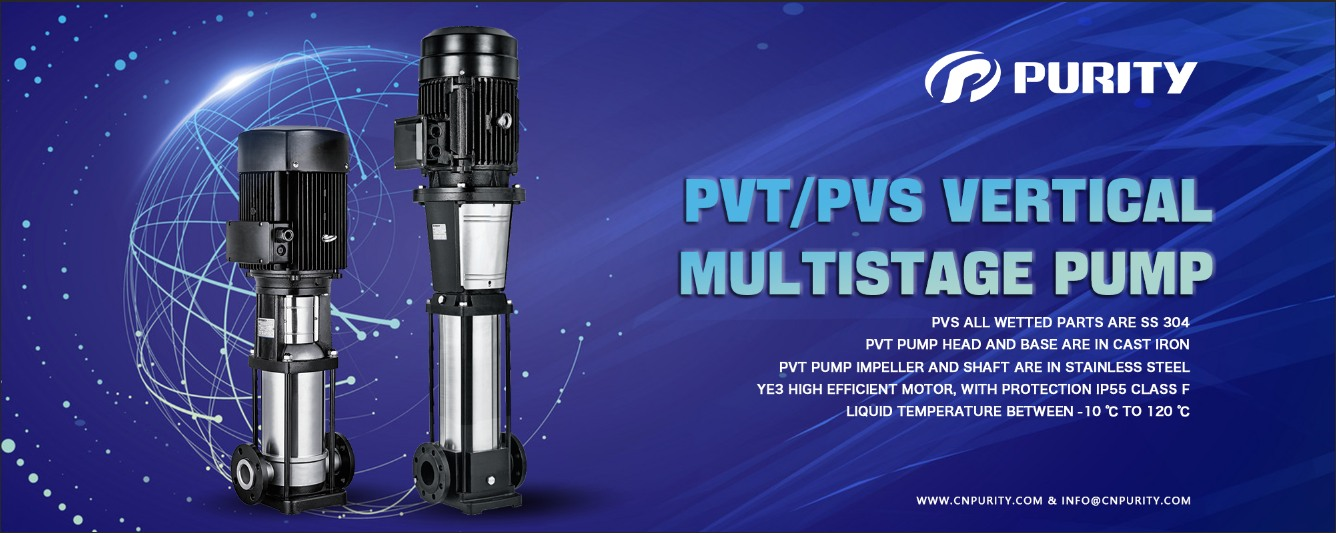Multistage pumps are advanced fluid-handling devices designed to deliver high-pressure performance by utilizing multiple impellers within a single pump casing. Multistage pumps are engineered to efficiently handle a wide range of applications that require elevated pressure levels, such as water supply, industrial processes, and fire protection systems.
Figure| Vertical Multistage Pump PVT
Structure of Vertical Multistage Pumps
The structure of a Purity vertical multistage pump can be divided into four primary components: stator, rotor, bearings, and shaft seal.
1.Stator: The pump centrifugal stator forms the core of the pump’s stationary parts, comprising several critical elements. These include the suction casing, middle section, discharge casing, and diffuser. The various sections of the stator are securely fastened together with tightening bolts, creating a robust working chamber. The pump centrifugal suction casing is where the fluid enters the pump, while the discharge casing is where the fluid exits after gaining pressure. The middle section houses the guiding vanes, which help direct the fluid efficiently from one stage to the next.
2.Rotor: The vertical centrifugal pump rotor is the rotating part of the centrifugal pump and is vital to its operation. It consists of the shaft, impellers, balancing disc, and shaft sleeves. The shaft transmits rotational force from the motor to the impellers, which are responsible for moving the fluid. The impellers, mounted on the shaft, are designed to increase the fluid’s pressure as it moves through the pump. The balancing disc is another crucial component that counteracts the axial thrust generated during operation. This ensures that the rotor remains stable and the pump operates smoothly. The shaft sleeves, located at both ends of the shaft, are replaceable components that protect the shaft from wear and tear.
3.Bearings: Bearings support the rotating shaft, ensuring smooth and stable operation. Vertical multistage pumps typically use two types of bearings: rolling bearings and sliding bearings. Rolling bearings, which include the bearing, bearing housing, and bearing cap, are lubricated with oil and are known for their durability and low friction. Sliding bearings, on the other hand, are composed of the bearing, bearing cover, bearing shell, dust cover, oil level gauge, and oil ring.
4.Shaft Seal: The shaft seal is crucial for preventing leaks and maintaining the integrity of the pump. In vertical multistage pumps, the shaft seal typically employs a packing seal. This seal is composed of a sealing sleeve on the suction casing, packing, and a water seal ring. The packing material is tightly packed around the shaft to prevent fluid leakage, while the water seal ring helps maintain the seal’s effectiveness by keeping it lubricated and cool.
Figure| Vertical Multistage Pump Components
Working Principle of Vertical Multistage Pumps
Vertical multistage centrifugal pumps operate based on the principle of centrifugal force, a fundamental concept in fluid dynamics. The operation begins when the electric motor drives the shaft, causing the impellers attached to it to rotate at high speed. As the impellers spin, the fluid within the pump is subjected to centrifugal force.
This force pushes the fluid outward from the center of the impeller towards the edge, where it gains both pressure and velocity. The fluid then moves through the guide vanes and into the next stage, where it encounters another impeller. This process is repeated across multiple stages, with each impeller adding to the fluid’s pressure. The gradual increase in pressure across the stages is what enables vertical multistage pumps to handle high-pressure applications effectively.
The design of the impellers and the precision of the guiding vanes are crucial to ensuring that the fluid moves efficiently through each stage, gaining pressure without significant energy losses.
Post time: Aug-30-2024





